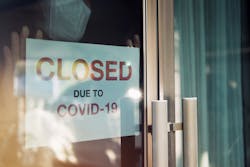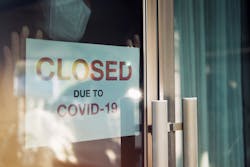A Surprise Safety Benefit of Sheltering in Place
After getting knocked down by the COVID-19 sucker punch of 2020, we’ve all been scrambling to get back up and regain some sense of balance in our personal and professional lives. In speaking with many of my colleagues across industries, it has become apparent that we have all learned some similar lessons... the hard way. One of those is managing the fine art of doing more with less — less revenue, less manpower, less hours, and less access.
In Hawaii, where a large portion of the economy is based on tourism, most hotels have all but shut down due to COVID-19 concerns. Although these facilities (and other types) are shut down, their engineering plants are not. The equipment is still up and running, and there are still engineering staff (albeit a skeleton crew) maintaining that equipment. A tip of the hat to these professionals who are mastering the fine art of doing more with less.
What can engineering directors and facility managers do to move their facilities closer to NFPA 70E compliance when spending has all but ground to a halt? The very phrase “NFPA 70E compliance” seems to conjure up ghastly visions of complex arc flash risk assessments and calculations with $50,000 price tags. Thus, it may not have occurred to them to work toward 70E compliance during a global pandemic. We all know the running joke within the maintenance community: The maintenance budget is always the first to get cut. As if it wasn’t difficult enough to get maintenance projects approved during normal times, I can only imagine the challenge these managers face now.
The good news is that there are some “no” to “low-cost” NFPA 70E compliance measures that can, and should, be performed during these trying times. Here are three strategies to consider.
Audits
This is another word maintenance workers love to hate. As a young submarine machinist in the Navy, I was horrified to think that the engineer or commanding officer would be watching me screw up some maintenance task that I hardly ever performed. Now that I’m older and wiser, I realize that audits get a bum rap.
Section 110.6(M) in NFPA 70E covers audits. You can handle this work in-house so you’re not spending money on an outside resource to complete the work. Here’s what the standard requires you to audit:
- Electrical safety program audit ― “The electrical safety program shall be audited to verify that the principles and procedures of the electrical safety program are in compliance with this standard. Audits shall be performed at intervals not to exceed three years.”
- Field work audit ― “Field work shall be audited to verify that the requirements contained in the procedures of the electrical safety program are being followed. When the auditing determines that the principles and procedures of the electrical safety program are not being followed, the appropriate revisions to the training program or revisions to the procedures shall be made. Audits shall be performed at intervals not to exceed one year.”
- Lockout/tagout program and procedure audit ― “The lockout/tagout program and procedures required by Art. 120 shall be audited by a qualified person at intervals not to exceed one year. The audit shall cover at least one lockout/tagout in progress. The audit shall be designed to identify and correct deficiencies in the following:
1. The lockout/tagout program and procedures.
2. The lockout/tagout training.
3. Worker execution of the lockout/tagout procedure.”
Training
The NFPA 70E standard includes requirements for three types of training:
- Electrical safety training [Sec. 110.6(A)]
- Lockout/tagout training [Sec. 110.6(B)]
- Emergency response training [Sec. 110.6(C)]
OSHA has been known to cite training violations as “Serious Violations,” which carry a maximum fine of $13,494 per violation!
Depending on the sort of training you implement, it could be free of cost or it may cost you a little something. Either way, now is a great time to make sure you have your training ducks all in a neat little row.
Training can be accomplished at your facility; for those workers deemed non-essential, it can be performed online in the privacy of their homes. Section 110.6(A) states that employees shall be trained:
- To understand the specific hazards associated with electrical energy.
- In safety-related work practices and procedural requirements.
- To identify and understand the relationship between electrical hazards and possible injury.
- Retraining in safety-related work practices and applicable changes in this standard shall be performed at intervals not to exceed three years.
- The training required by Sec. 110.6(A) shall be classroom, on-the-job, or a combination of the two. The type and extent of the training provided shall be determined by the risk to the employee.
Section 110.6(B) states that employees involved in or affected by the lockout/tagout procedures required by Sec. 120.2(B) shall be trained in the following:
- The lockout/tagout procedures.
- Their responsibility in the execution of the procedures.
- Retraining in the lockout/tagout procedures shall be performed as follows:
- When the procedures are revised.
- At intervals not to exceed three years.
- When supervision or annual inspections indicate that the employee is not complying with the lockout/tagout procedures.
Section 110.6(C) covers training for:
- Contact release
- First aid
- Emergency response and resuscitation
Training shall occur at a frequency that satisfies the requirements of the certifying body.
Since I’m an electrical consultant, my focus would be on electrical safety training. However, as a quick aside, regardless of your industry or profession, OSHA publication 2254, titled “Training Requirements in OSHA Standards,” is an exhaustive guide that covers all OSHA training requirements.
Electrical safety program
I’ve consulted with almost every type of facility that you can think of — including banks, museums, universities, shopping centers, hospitals, and astrophysical telescope facilities, to name a few. Invariably, their electrical safety program (ESP) is not up to snuff. Many times, they give me the “deer-in-the-headlights” stare when I ask about their ESP; this lets me know right away that they are not in compliance in this area.
Section 110.5 covers the ESP requirement and states: “The employer shall implement and document an overall electrical safety program that directs activity appropriate to the risk associated with electrical hazards.”
If you’ve never designed an ESP from scratch, these can be something of an administrative beast to create. The good news is it won’t cost you any money to sit down and have a go at building this yourself. Keep in mind, however, that this document is the policy that covers every aspect of electrical safety at your facility. The Informative Annex “E” in NFPA 70E provides a sample ESP that lists all of the principles, procedures, and controls that go into creating a quality ESP. With that being said, don’t ignore other valuable references available in the market, such as OSHA’s Occupational Safety & Health Standards and the ANSI Z-10 standard.
In closing, effective NFPA 70E compliance solutions don’t always cost money to implement. Even if you or most of your team have been relegated to working from home, you can still work toward compliance and make a difference in the safety and well-being of your workforce.
Mike Dillard is the CEO & president of iOn Reliability Training & Consulting, a national training corporation. He can be reached at [email protected].


